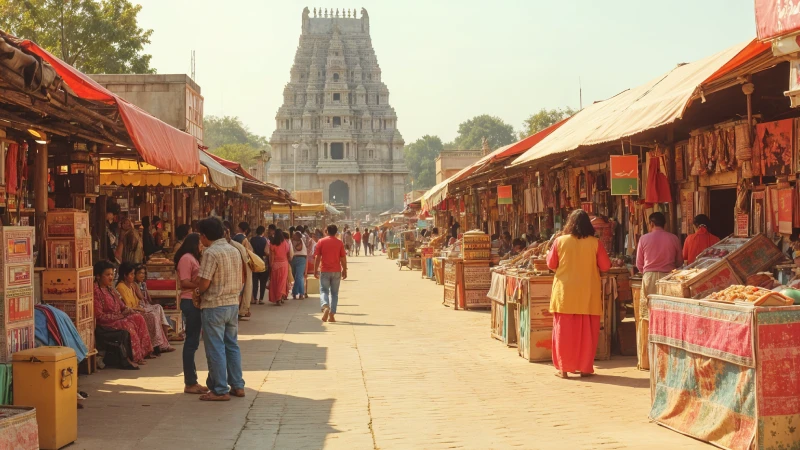Hampi, a UNESCO World Heritage Site nestled in Karnataka, India, is a destination that captivates travelers with its ancient ruins, stunning landscapes, and vibrant culture. But beyond its historical marvels, Hampi is also a haven for shoppers. The local markets here are brimming with traditional handicrafts, unique souvenirs, and cultural treasures that reflect the rich heritage of the Vijayanagara Empire. In this comprehensive guide, we’ll dive deep into Hampi’s local markets, uncovering what makes them special, what to buy, and how to make the most of your shopping experience.
Why Hampi’s Local Markets Are a Must-Visit
Hampi’s markets are not just about shopping; they are a gateway to understanding the region’s culture, traditions, and artistry. Here’s why you should add these markets to your itinerary:
- Rich Cultural Heritage: Every item sold in these markets tells a story of Hampi’s glorious past and its connection to the Vijayanagara Empire.
- Handmade and Authentic: From stone carvings to handwoven textiles, the products are crafted by skilled local artisans using traditional techniques.
- Affordable and Unique: Unlike commercialized tourist spots, Hampi’s markets offer one-of-a-kind items at reasonable prices.
- Cultural Exchange: Shopping here allows you to interact with locals, learn about their way of life, and support their livelihoods.
Top Markets in Hampi You Can’t Miss
1. Hampi Bazaar: The Heart of Shopping in Hampi
Located near the iconic Virupaksha Temple, Hampi Bazaar is the most famous market in the region. This bustling marketplace is a sensory delight, with vibrant colors, aromatic spices, and the sounds of artisans at work.
- What to Buy:
- Stone Carvings: Miniature replicas of Hampi’s temples and statues of deities.
- Traditional Jewelry: Silver and brass ornaments like earrings, necklaces, and bangles.
- Textiles: Handwoven silk and cotton sarees, scarves, and stoles.
- Best Time to Visit: Early morning or late afternoon to avoid the midday heat.
- Pro Tip: Bargaining is expected here, so don’t shy away from negotiating politely.
2. Virupaksha Bazaar: A Blend of Tradition and Modernity
Virupaksha Bazaar is another must-visit market, known for its lively atmosphere and diverse range of products. It’s a great place to explore the fusion of traditional and contemporary items.
- What to Buy:
- Handicrafts: Wooden carvings, handmade pottery, and traditional paintings.
- Spices: Fresh turmeric, cardamom, black pepper, and jaggery.
- Clothing: Ethnic wear like kurtas, dupattas, and dhotis.
- Best Time to Visit: Evenings, when the market is beautifully lit and buzzing with activity.
- Pro Tip: Engage with the artisans to learn about the history and significance of their crafts.
3. Kamalapura Market: A Hidden Gem
For a quieter and more authentic shopping experience, head to Kamalapura Market. Located near the Kamalapura Museum, this market is perfect for those who want to avoid the crowds and explore at their own pace.
- What to Buy:
- Handmade Pottery: Unique clay pots, vases, and decorative items.
- Traditional Paintings: Artworks depicting scenes from Hampi’s history and mythology.
- Local Produce: Fresh spices, jaggery, and organic honey.
- Best Time to Visit: Mid-morning, when the market is less crowded.
- Pro Tip: Take your time to explore the market and interact with the friendly vendors.
What to Buy in Hampi’s Markets: A Detailed Guide
1. Stone Carvings: A Piece of Hampi’s Legacy
Hampi is renowned for its intricate stone carvings, which are a testament to the region’s architectural brilliance. These carvings make for timeless souvenirs.
- Popular Items: Miniature temple replicas, statues of deities, and decorative pieces.
- Price Range: ₹500 to ₹5000, depending on the size and intricacy.
- Why Buy: Each piece is a work of art that reflects Hampi’s rich history and craftsmanship.
2. Traditional Jewelry: Adorn Yourself with Culture
Hampi’s markets are a treasure trove of traditional Indian jewelry, crafted from silver, brass, and other metals.
- Popular Items: Earrings, necklaces, bangles, and anklets.
- Price Range: ₹200 to ₹2000.
- Why Buy: These pieces are not just accessories but also a reflection of India’s cultural heritage.
3. Handwoven Fabrics: Wear the Colors of Hampi
The markets of Hampi offer a variety of handwoven fabrics, including silk and cotton sarees, scarves, and stoles.
- Popular Items: Ilkal sarees, Banarasi silk, and cotton scarves.
- Price Range: ₹300 to ₹5000.
- Why Buy: These fabrics are lightweight, durable, and perfect for both casual and formal occasions.
4. Spices and Local Produce: A Taste of Hampi
Hampi’s markets are also a great place to buy fresh spices and local produce, which are essential ingredients in Indian cuisine.
- Popular Items: Turmeric, cardamom, black pepper, and jaggery.
- Price Range: ₹50 to ₹500 per pack.
- Why Buy: These spices are fresh, aromatic, and perfect for adding flavor to your dishes.
Tips for an Unforgettable Shopping Experience in Hampi
- Bargain Respectfully: Bargaining is common in Hampi’s markets, but always do so with a smile and respect.
- Carry Cash: While some vendors may accept digital payments, cash is still the preferred mode of payment.
- Check for Quality: Ensure that the items you buy are genuine and not mass-produced imitations.
- Respect Local Customs: Be mindful of local traditions and customs while interacting with vendors and artisans.
How to Reach Hampi’s Markets
Hampi is well-connected by road, rail, and air. The nearest railway station is Hospet Junction, which is about 13 km from Hampi. From there, you can hire a taxi or take a local bus to reach the markets. The nearest airport is Vidyanagar Airport, which is approximately 40 km away.
Final Thoughts: Take Home a Piece of Hampi’s Heritage
Hampi’s local markets are more than just shopping destinations; they are a celebration of the region’s culture, history, and craftsmanship. Whether you’re looking for traditional handicrafts, vibrant textiles, or authentic souvenirs, these markets have something for everyone. So, the next time you visit Hampi, make sure to explore its bustling markets and take home a piece of this ancient city’s rich heritage.

